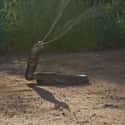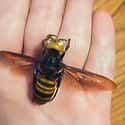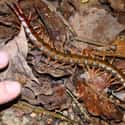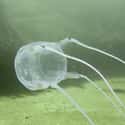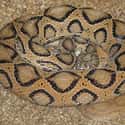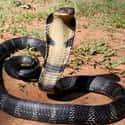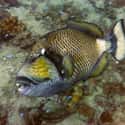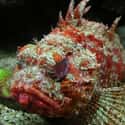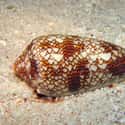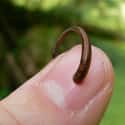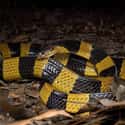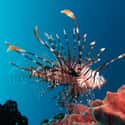-
(#1) Spitting cobra
Not all cobras can spit, but the ones who can are pretty scary. About 14 of the 28 members of the Naja species are able to spit and can be found in parts of Africa and Asia. The fangs of these snakes are modified with tiny holes that shoot venom. Spitting cobras also have amazing accuracy. The snakes deliberately aim for the eyes in order to blind threats. Since their venom contains cytotoxins and neurotoxins, anyone who gets hit will have to deal with corneal swelling, paralysis, or possibly even permanent blindness. The cobras can hit a target up to eight feet away, so you don't have to get up close and personal to be in danger.
-
(#2) Asian giant hornet
- Vespa mandarinia
Asian giant hornets are appropriately named since they are the largest hornets in the entire world. Members of the wasp family, they live throughout Eastern Asia and can grow to almost two inches long; the queens are even larger. The hornet's stinger does not detach like some other wasp species, so it can sting a victim multiple times. The venom contains around eight chemicals which can cause pain and breathing difficulties.
Giant hornets are also very fast, sometimes flying up to 25 miles per hour. Most humans whom die after an attack are allergic to the venom.
-
(#3) Giant Centipede
If you've ever encountered a normal centipede, this one is about 10 inches longer. Also known as Asian forest centipedes or Chinese red-headed centipedes, these odd creatures can be found in damp places under rocks or foliage. The giant centipede is large, and it bites, leaving victims in terrible pain. Giant centipedes attack with their front legs which have specialized, poisonous pincers. The venom is powerful enough to paralyze smaller creatures such as fish. It also causes severe problems for young children or the elderly. A giant centipede's bite normally isn't deadly for humans, but it can be very painful.
-
(#4) Monocled Cobra
Monocled cobras can be identified by the round shape on the back of their hoods. They can grow up to seven feet long and strike very quickly, making these snakes all the more dangerous. The monocled cobra's venom is even more deadly than the king cobra's. And it has the highest human fatality rate in the country. Like other cobras, the monocled's venom contains neurotoxins which can cause paralysis, heart attack, and respiratory failure. Death can occur in less than an hour if treatment isn't received. Even a scratch from a monocled cobra's fang can be disastrous. Plus, they tend to strike more than once.
-
(#5) Box jellyfish
- Chironex fleckeri
While the waters around Australia are famously known to hold the world's most poisonous jellyfish, the lethal creatures can lurk off the coast of Thailand as well. In fact, they can be found throughout the Indo-Pacific, killing as many as 40 people a year in the Philippines alone. But since attacks aren't always reported, these jellies can be even more deadly than we think. Each has around 15 tentacles that can be up to 10 feet long, complete with about 5,000 stingers.
These stingers trigger a chemical reaction within prey, releasing a venom that attacks the nervous system and heart, sometimes causing shock. Box jellyfish victims have even drowned before making it back to shore due to heart attacks or extreme pain. Even more concerning, this particular fish is blue or clear in color; the victims rarely see the predator approach.
-
(#6) Russell's Viper
Thailand is also home to Russell's vipers, some of the most deadly snakes in Asia. Their fangs are longer than those of other snakes, and the creatures grow almost six feet long. The viper can strike victims several feet away with incredible speed, but it feeds on small rodents in large fields. The Russell's viper venom acts quickly, causing renal failure, paralysis, or hemorrhaging.
Many victims who survive have kidney problems for the rest of their lives.
-
(#7) King Cobra
- Ophiophagus hannah
While a snake slithering on the ground might not scare many people, a snake that stands up is scary to almost everyone. Since king cobras can lift a third of their bodies off the ground and grow up to 18 feet long, they can stand and attack simultaneously. The predators are incredibly shy, generally avoiding people. But when threatened, they become very aggressive, flashing their hoods and hissing. The king cobra is the longest venomous snake in the world, but luckily its venom is not the most potent.
Don't lower your guard, though, because the amount of neurotoxins in king cobra venom is staggering. A single bite can kill an elephant or as many as 20 people.
-
(#8) Titan triggerfish
- Balistoides viridescens
Titan triggerfish may be pretty, but they notoriously attack human swimmers when they feel threatened. Mating periods are especially dangerous. Divers claim the fish roll onto their sides and stare with beady eyes before attacking. Triggerfish teeth can pierce wetsuits and fins. The creatures even rip off people's ears. A poison called ciguatoxin passes from fish to prey, causing serious infection when left untreated. Triggerfish may also headbutt you. They leave large bruises and knock out some divers.
-
(#9) Scorpionfish
- Scorpaenidae
Sometimes called rockfish since they roam among the rocks on the ocean floor, scorpionfish have body markings that allow for easy camouflage. Their spines also contain venom that subdues and kills prey which get swallowed whole. Although the venom isn't often fatal to humans, you might end up in a lot of pain if you brush against one. Numbness, swelling, and bleeding, might occur and medical attention should be sought to avoid possible seizures, vomiting, or breathing difficulties. Scorpionfish can live out of water for 24 hours, so it's probably wise to avoid them if they wash up on the beach.
-
(#10) Cone snail
- Conidae
Even snails in Thailand can be deadly. The innocent looking cone snail has a proboscis safely hidden under its shell that can shoot out and poison prey. The venom contains conotoxins and triggers heart failure or paralysis, killing prey within minutes. While cone snails aren't normally trouble for humans, many people are attacked when they pick up the bright, patterned creatures. Snails fight back with enough force to pierce a diver's wetsuit. If the snail is big enough, it may pump enough venom into a human to cause numbness, vision problems, vomiting, paralysis, breathing difficulties, and even death.
-
(#11) Leech
- Hirudinea
Emerging from the water to find a thirsty leech attached to your body can be horrifying, but in Thailand, you don't even have to go into the water to be attacked. Jawed land leeches can be found throughout Southeast Asia, including on the ground in Thailand's jungles and forests. They have two or three jaws that latch on prey and suck blood. Land leeches detect victims' body heat and attach to people. The leeches are so numerous during certain times of the year that leech socks are available for purchase. Since they resemble plastic leg warmers, these socks aren't the most fashionable accessories but they do prevent leech attacks.
-
(#12) Banded Krait
The black and yellow coloring of Thailand's banded kraits is a warning to take care. These snakes average a length of about five feet and are considered highly dangerous. Their extremely potent venom can paralyze nervous systems, causing asphyxiation or other organ failure. People die only hours after being attacked. Banded kraits typically consume other snakes, though. And luckily, they aren't aggressive unless provoked. The nocturnal creatures can be easily avoided.
-
(#13) Tiger shark
- Galeocerdo cuvier
Tiger sharks attack humans almost as much as great whites. These sharks average about 10 feet long, and they have tiger-like banding on the skin. Their blue-green color allows for camouflage in the water; they like to sneak up on prey. Tiger sharks are not picky eaters. They consume license plates, trash bags as well as turtles and other fish. Their excellent senses of smell, sharp teeth, and powerful jaws make them efficient hunters. Tiger sharks crush the hard shells of turtles and clams. Tiger sharks don't normally chase prey, but they tend to stick around after biting humans, unlike great whites who usually swim away.
-
(#14) Red Lionfish
- Pterois volitans
If anything in nature served as a neon sign warning others not to come too close, it would be the red lionfish, also sometimes called the dragon fish. Red and yellow zebra-like stripes line its body and about 18 fancy dorsal fins convince others to keep their distance. Those fins are highly venomous, harming prey and careless humans. Although the lionfish venom isn't strong enough to kill a healthy human, it can cause extreme pain and nausea. The fish causes the most problems for swimmers, divers, and snorkelers who hang out by the coral and rocks. It can be aggressive when necessary and it moves incredibly quickly.
-
(#15) Stinging Nettle Caterpillar
If you think touching a stinging nettle caterpillar looks like it would be painful, you'd be absolutely correct. Stinging nettle caterpillars have tiny suckers on their bodies, allowing them to stick to leaves and branches as they travel and feed. Additionally, their bodies are covered in sharp points. The points can cause a painful rash and breathing problems. The creatures live throughout Southeast Asia and sometimes hitch rides on plant cargo. Now they're even considered an invasive species in Hawaii. Like other caterpillars, the sting nettles will eventually mature into moths. The moths, however, are less dangerous.
-
(#16) Indochinese Tiger
- Panthera tigris corbetti
There are actually two species of tigers found in Thailand, the Indochinese and the much smaller Malayan tigers; unfortunately both are endangered. There may be less than 1,800 Indochinese tigers left in the world; in China they are believed to be completely extinct. Despite their lack of numbers, Indochinese tigers are well equipped predators, attacking and feasting on large mammals such as deer and wild hogs.
These tigers are solitary hunters, chasing prey with great speed and using their powerful jaws to maim. The Indochinese animals can also kill humans. While tiger attacks are still relatively rare, don't provoke them.
-
(#17) Clouded Leopard
- Neofelis nebulosa
Clouded leopards are so mysterious; it's not entirely clear how they act in the wild. The cats that have been studied in captivity aren't even able to roar or purr. They are relatively small at up to three feet long, but their impressive hunting skills make them scary. Clouded leopards have the proportionally largest teeth of all wild cats, and their jaws open as wide as 100 degrees. Rotating rear ankles allow the cats to descend tree trunks headfirst like squirrels. Researchers witnessed the leopards aggression towards one another during feeding. Some females are even killed by males during the mating processes.
New Random Displays Display All By Ranking
About This Tool
We all know that most Thais love to cook insects. People will see a variety of insect dishes in Thai snack streets and night markets, these ingredients come from the local and contain beetles, caterpillars, crickets, star anise spiders, etc. Because of the hot and humid climate and unique natural environment in Thailand, here is the best habitat for many terrifying animals, and we have to admit that some animals are dangerous.
For most travelers, all kinds of insects are indeed very scary. Here the random tool lists 17 of the terrifying animals from Thailand that can even ruin the beach vacation. We recommend that tourists should prepare some anthelmintics and heatstroke prevention pills, or purchase in Thailand.
Our data comes from Ranker, If you want to participate in the ranking of items displayed on this page, please click here.






